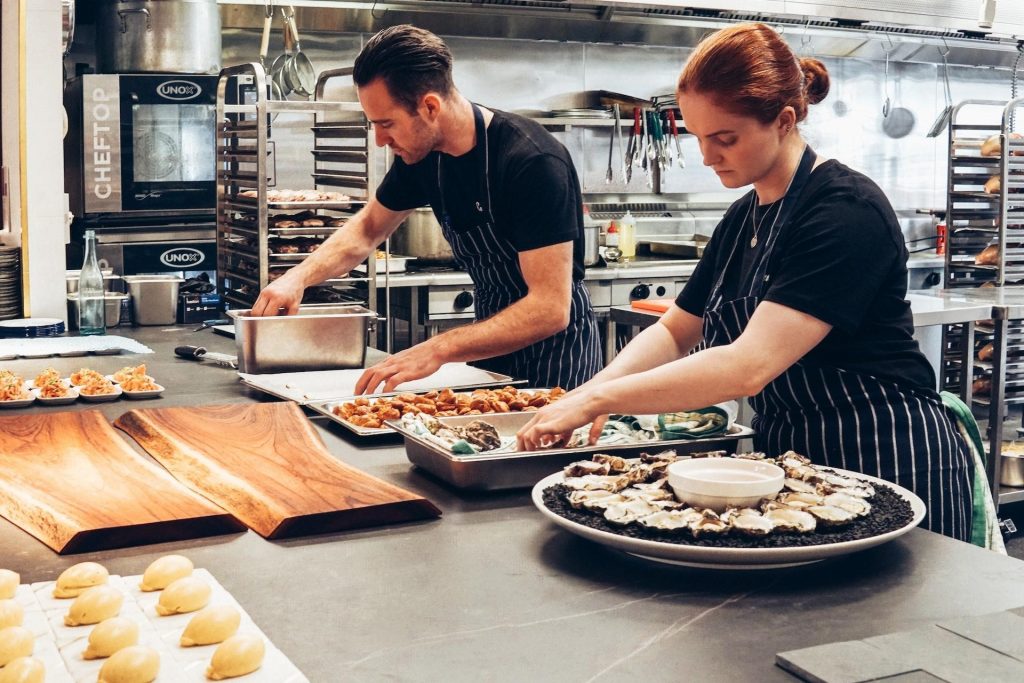Apart from delicious and quality food, people also expect quick and high-quality service, courteous staff, greater delivery options, and much more from a restaurant.
Improving the efficiency of a business not only results in customer satisfaction and better profits but also improves the overall reputation of a dining place in a market. To ensure that people have positive expectations about your restaurant, you must serve the customers in the best ways possible.
Restaurants must ensure that their profits are increasing over a period. However, they may operate on a tighter margin when compared to other industries. Therefore, restaurants must make use of all the measures available to improve their efficiency and profitability with an effective innovation strategy in place.
Below are 7 innovative strategies to ensure that you can increase your profit margins and efficiency and can delight your customers every time they visit or order from your restaurant business.
1. Make Use of Technology
 The technology that is used in a restaurant may impact its efficiency to a great extent. For instance, most restaurants nowadays use POS (Point-of-Sales) systems for receiving and placing orders. Ensure that you are using the fastest communication networks and intuitive and new software so that all your staff can easily use the systems and deliver exceptional customer experiences.
The technology that is used in a restaurant may impact its efficiency to a great extent. For instance, most restaurants nowadays use POS (Point-of-Sales) systems for receiving and placing orders. Ensure that you are using the fastest communication networks and intuitive and new software so that all your staff can easily use the systems and deliver exceptional customer experiences.
A common mistake that restaurant owners make while purchasing their POS system is that they may choose any retail POS system instead of a specialized restaurant POS system. While certain needs may be common, there are unique operational challenges of restaurants that are different from the other retail businesses.
Some of the important characteristics of the latest POS systems that may help restaurants increase their efficiency and profitability include:
- Tracking customer demand-related trends (through the reliable food traceability app features)
- Making changes remotely through features such as pricing, push menu, and location-based promotions, among others.
- A simple and intuitive interface to facilitate multiple ordering methods (including table-side ordering).
- Forecasting through analyzing data in real time.
- Integration of all the back and front systems and operations through a single dashboard.
- Real-time reporting on critical metrics (including best sellers).
2. Automate Tasks
 While automation systems may appear to be coming at a premium cost, they can provide phenomenal returns on investments and improve your profitability overall. Improvement in communication and operational technologies ensures that many different tasks can be automated completely.
While automation systems may appear to be coming at a premium cost, they can provide phenomenal returns on investments and improve your profitability overall. Improvement in communication and operational technologies ensures that many different tasks can be automated completely.
These tasks may include reservations, payments, ordering, and many others. Partial automation may also improve efficiency, where complete automation is not possible. Automation may also ensure that you can save time and money you spend every month on paying your employees their salaries.
3. Choose Your Suppliers Carefully
 Choosing the suppliers carefully and following lean and continuous improvement practices can improve your profitability and efficiency. Restaurant managers and owners should aim to balance quality and cost. They must evaluate the suppliers and see to it which ones are offering better discounts while not compromising the quality and the deadlines. Lean approaches like Just-in-Time (JIT) reduce inventory carrying costs.
Choosing the suppliers carefully and following lean and continuous improvement practices can improve your profitability and efficiency. Restaurant managers and owners should aim to balance quality and cost. They must evaluate the suppliers and see to it which ones are offering better discounts while not compromising the quality and the deadlines. Lean approaches like Just-in-Time (JIT) reduce inventory carrying costs.
It is also necessary to track the reliability and performance of the suppliers to ensure greater efficiency and to gain customer trust. Because reputation has a direct impact on profitability, you should ensure that your suppliers do not compromise with health and safety standards. Reliable software for the distribution of food can help you gain more information on your distribution network and ensure that you can make improvements in the right areas.
4. Make Use of New Revenue Generation Streams
 The modern technologies available today not only improve your efficiency but can also be a source of new business. For instance, there are a variety of food delivery apps and businesses available that connect customers (including residential and business customers) with restaurants and hotels. You should ensure that your offerings are available on these apps as well and customers can order them from anywhere they like. You do not have to open any new facilities and can improve your sales and profitability while keeping the operational costs the same.
The modern technologies available today not only improve your efficiency but can also be a source of new business. For instance, there are a variety of food delivery apps and businesses available that connect customers (including residential and business customers) with restaurants and hotels. You should ensure that your offerings are available on these apps as well and customers can order them from anywhere they like. You do not have to open any new facilities and can improve your sales and profitability while keeping the operational costs the same.
Another innovative measure can be partnering with other hotels and restaurants in your area and creating innovative cuisines and new food offerings.
Furthermore, restaurants are gaining greater revenues by selling retail products as well. Adding more products to your selling basket ensures that the customers find your business and restaurant to be a one-point destination for fulfilling many of their needs and requirements. Such retail products can be sold online and at physical locations and in-house.
5. Train Your Employees

Employees should be trained in multiple tasks and activities related to business operations, including cuisine preparation and customer service, among others. While the training pertains to the actual responsibilities of an employee, it is always helpful to make the employees understand the big picture and cross-train them for better efficiency.
Customer service and following proper etiquette make a definitive impact on the efficiency, reputation, and sales of any restaurant, hotel, and hospitality business. However, employees should also be trained in other related areas (including effective communication) to ensure that they can collaborate well enough to deliver high-quality customer service and improve customer experience.
6. Promotion of Business
 Modern technologies including social media ensure that you can promote your business easily to the target customers in your area. Promotion can bring you many new customers online as well as in-house and at the physical restaurant location. You can ask your customers to leave feedback by sending them messages on their smartphones.
Modern technologies including social media ensure that you can promote your business easily to the target customers in your area. Promotion can bring you many new customers online as well as in-house and at the physical restaurant location. You can ask your customers to leave feedback by sending them messages on their smartphones.
The messages can be shared on social media apps as well as other online forums and help improve business reputation and sales. The feedback obtained by customers can also be used for finding out the issues and problems troubling the customers and for improving the operations and customer service in specific areas.
7. Give Back to the Community
 Customers like to associate with businesses that are ethical and sustainable. A restaurant business that can give back to the society and community in which it operates will be preferred by people.
Customers like to associate with businesses that are ethical and sustainable. A restaurant business that can give back to the society and community in which it operates will be preferred by people.
Simple measures including using recycled packaging material, donating excess food, using solar energy for operations, and the like can improve the reputation of a business as well as its efficiency. Over a period, these measures will not only improve your profits but will make your business and community more sustainable as well.
Takeaway
If you run a restaurant in London or anywhere in the world, you need to use innovative strategies and the newest technologies (such as food distribution software and food ordering and food traceability apps) to lead the competition and remain sustainable. Restaurant businesses should also try to build their reputation and ensure that they can get repeat business by delivering exceptional food and customer service.
The listed innovative strategies should help every restaurant owner and manager with making their hospitality business more efficient, profitable, and successful.
Author Profile

- Blogger by Passion | Contributor to many Business Blogs in the United Kingdom | Fascinated to Write Blogs in Business & Startup Niches
Latest entries
 BusinessApril 11, 2025How Hiring a Student Could Be the Best Move Your Business Makes
BusinessApril 11, 2025How Hiring a Student Could Be the Best Move Your Business Makes Living in LondonApril 9, 20255 Key Considerations for Long-Term Urban Rentals
Living in LondonApril 9, 20255 Key Considerations for Long-Term Urban Rentals EntertainmentApril 3, 20257 Slot Games that are Popular with Londoners
EntertainmentApril 3, 20257 Slot Games that are Popular with Londoners EventsMarch 25, 2025EGR Awards 2025: London’s Comeback After Losing ICE
EventsMarch 25, 2025EGR Awards 2025: London’s Comeback After Losing ICE




